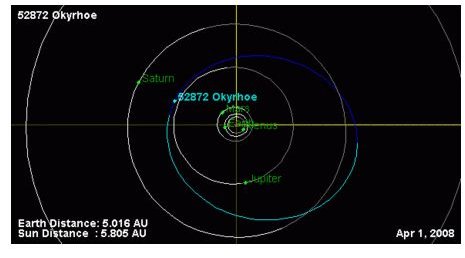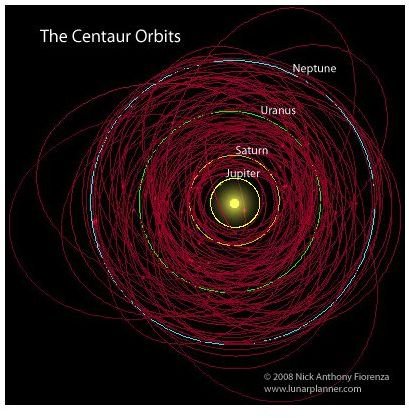Comets or Asteroids or What? - Facts & Information About the Centaur Planets
What Are Centaur Planets?
Centaurs, sometimes called Centaur planets, are minor planets that orbit the Sun. Their orbits usually lie between those of Jupiter and Neptune. However, some have orbits that extend just beyond Mars, and others have orbits that extend beyond Neptune. The orbits of Centaur planets cross those of the giant outer planets and are influenced by their gravity. As of mid-2010, there were around 85 known Centaurs.
Various Sizes
Those that have been measured range in size from tens to hundreds of kilometers across, and they are expected to have lifetimes of a few million years. However, astronomers suspect there are many smaller Centaur planets just waiting to be discovered. Additionally, some comets, including 39P/Oterma and 29P/Schwassmann-Wachmann 1 have orbits that may someday cause them to be classified as Centaurs as well.
Origins of the Name
In mythology, Centaurs were creatures that were part horse, part man, known for their exciting, warlike adventures. In astronomy, Centaur planets have characteristics of both asteroids and comets, and in fact some are classified as both.
Is It a Centaur?
Classifying Centaur planets isn’t a precise science, because Centaurs, comets, asteroids, objects in the Kuiper Belt and the Scattered Disk form a continuum, with some bodies having characteristics of more than one. The scientific consensus is that Centaurs are objects in transition. For example, Chiron, the first object to be designated as a Centaur, is now also classified as a comet, because it was discovered to have a coma around it, which is a glowing halo of dust and gas enveloping a comet’s nucleus.
Asteroids and Comets
By 2008, two other Centaur planets, 60558 Echeclus and 166P/NEAT, were discovered to have cometary comas. Chiron and

Echeclus are officially classified as both asteroids and comets. Another Centaur, 52872 Okyrhoe, is suspected of displaying comet-like traits as well. In fact, any Centaur whose orbit shows perturbations close enough to the Sun is anticipated to become a comet. And when that happens, what a show it could be! A Centaur approaching the Sun would be brighter many times over than other comets in recorded history.
Hard to Find
So far, no official Centaur has been photographed closely. However, there is some evidence that Phoebe, one of Saturn’s moons, may be a Centaur caputered by Saturn’s orbit. Phoebe was photographed by the Cassini space probe in 2004. Another possible Centaur, 8405 Asbolus, has been imaged by the Hubble Space Telescope.
Double Centaurs
Adding to the mystique of the planetary Centaurs is the fact that some have been discovered to be double Centaur planets. The Hubble Telescope has discovered at least two double Centaurs. They look like a single object, but closer inspection reveals that they are indeed two objects, orbiting one center of gravity in a grand ballroom dance across the sky.
Where Do They Come From?
Where do these fascinating objects come from? There is some evidence that many of them come from an area known as the Trojan clouds. These are vast reservoirs of bodies that move in resonance with our Solar System’s giant planets, primarily Jupiter and Neptune. Computer simulations show that an ongoing supply of objects should be leaving the Trojan clouds, moving into orbits that would classify them as Centaurs. What proportion of Centaurs may come from this region is as yet unknown.
Summary - More to Come
One thing that is certain about Centaurs is that they will continue to generate much intriguing speculation and research as more are found and characterized. Centaurs pose a kind of mystery - and in doing so require more clear definitions by the astronomical community.
References and Image Credits
https://earthsky.org/space/astronomers-discover-first-double-centaurs
https://filer.case.edu/~sjr16/advanced/asteroid.html
https://arxiv.org/abs/1007.2541
https://www.minorplanetcenter.org/iau/lists/Centaurs.html
